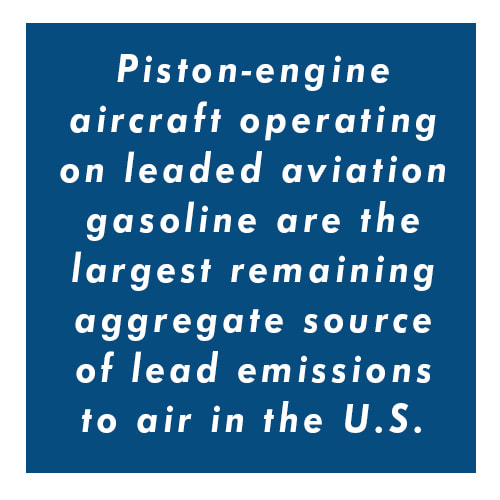- Background
-
Affected Areas
-
Front Range Airports
- Boulder Municipal Airport | BDU
- Centennial Airport | APA
- Colorado Springs Municipal Airport | COS
- Denver International Airport | DIA
- Erie Municipal Airport | EIK
- Front Range Airport | CFO
- Greely-Weld County Airport | GXY
- Meadow Lake Airport | FLY
- Northern Colorado Regional Airport | FNL
- Parkland Estates Airpark
- Rocky Mountain Metropolitan Airport | BJC >
- Van Aire Skyport |
- Vance Brand Municipal Airport | LMO
- OTHER COLORADO AIRPORTS
- Issues
- Press
- Contact
- FIND YOUR STATE
What is Avgas? Does it contain lead?
General aviation aircraft are largely single-engine piston planes, which make up the majority of flights in and out of General Aviation airports in the United States (more widely thought of as generally regional airports). In 2010, piston-engine aircraft made up approximately 70% of the GA fleet. These fleets are almost entirely fueled by avgas, which is the most widely commercially available fuel. Avgas contains lead; specifically tetraethyl lead, which is used to boost octane in engines. This was commonly used in vehicle gasoline until it was phased out almost entirely by 1986 in the United States because of its harmful health effects. More importantly, TEL has not yet been banned for use in avgas, because no operationally safe alternative is currently available. And although avgas comes in different standards of levels of lead, including unleaded, almost all avgas on the market today is 100LL or low-lead (but not unleaded). The EPA has decide to look for alternative fuel sources while phasing out leaded avgas over a number of years. The federal government convened a task force in 1997 to address sources of environmental lead contamination, specifically for childhood exposures, and although lead from aviation emissions is known to be the majority source of lead exposure in the air, to date no changes has been made to avgas 100LL being the primary source of fuel for general aviation aircraft.
|
Children and Lead Exposure
|
Lead exposure is most detrimental to children. It can impact learning, attention, and memory. The EPA claims that "Much of our exposure comes from human activities including the use of fossil fuels including past use of leaded gasoline, some types industrial facilities and past use of lead-based paint in homes". However, lead is still present in aviation fuel and shows no sign of changing anytime soon.
According to the EPA: "Even low levels of lead in the blood of children can result in:
Lead exposure to children can result from multiple sources and can cause irreversible and life-long health effects. No safe blood lead level in children has been identified. Even low levels of lead in blood have been shown to affect IQ, ability to pay attention and academic achievement. The childhood impacts of lead exposure are so significant that it has become a high priority for local communities to address the source of lead contamination. The City of Denver has recently undertaken a substantial project to replace the leaded pipes in its distribution system. The city of Flint, Michigan, did not address the lead contamination soon enough, and the effects on the health of the children who drank municipal water from these pipes has been substantial.
|
The Federal Government is concerned about the effects of lead exposure to children. In their 2018 publication, Federal Action Plan to Reduce Childhood Lead Exposures and Associated Health Impacts, their top include limiting lead exposure in lead-based paints, drinking water, soil, and emissions to ambient air.
Currently, the source category with the greatest contribution to total U.S. air emissions is piston-engine aircraft operating on leaded fuel (EPA, 2018d; Task Force, 2016). Actions are suggested to reduce these exposures. The first is to evaluate the impacts of the lead emissions from aviation, and the second is to look for alternative fuel sources through the Piston Aviation Fuel Initiative. That initiative is currently underway, although it has been delayed because of the pandemic and to date there has been no update on the status of this research initiative.
The EPA says that 'The most important step parents, doctors, and others can take is to prevent lead exposure before it occurs. We know that small piston-engine planes use lead-based AVgas. We know that for a majority of the piston-engine fleet, alternative fuels containing no lead can be used with no modification to the engine. We know that these planes fly over our communities with no limits. It's time to take the advice of the EPA in addressing lead exposure for children in our communities, as well as others, and advocate vociferously for the replacement of leaded fuels for aviation. Given that lead is a known hazard to health, especially to the health and development of children, why isn't something being done to address this issue? The time is now. Alternatives fuels exist; electric planes are being developed; air traffic can be routed over areas that will less directly impact the health of people below. |
What can be done?
|
There are several options to address this issue, both in the short-term and long. One easy and immediate solution is to route GA traffic to the extent possible to avoid residential areas, schools, and parks. Most airports publish guidelines specific to their area of places to avoid. At most altitudes, especially for GA aircraft, densely populated areas, schools, and parks are easy to identify and avoid mid-flight.
There is another option, albeit one that requires some investment on the part of the airports in infrastructure. There are currently commercially available unleaded aviation gas alternatives that 2/3 of the US's GA fleet can run on with no engine or mechanical modifications - UL94 is one of them. Price competitive, and available from the original manufacturer (as well as licenseable to other fuel manufacturers should the demand grow), it is price competitive with current aviation fuels and offers a plug and play solution to addressing the issues of lead exhaust for human health. The small cost of adding additional fuel tanks to airport maintenance facilities is minuscule compared to the economic implications of the detrimental effects on human life. There should be no hesitation on the part of airport authorities to limit the lead exposure to airport users and surrounding residents with immediate effect. Why is this not in widespread use? It is simply a matter of demand. Swift Fuels, who currently manufactures UL94, is ready and waiting to deliver any amount of this fuel to any airport that asks. What is currently missing is the demand from both pilots and the public to use this unleaded alternative to standard leaded avgas. With increased pressure on airports, public officials, and other decision makers, it may be possible to make a difference in the lead exhaust in our skies today. |
Per the EPA:
"EPA has established standards designed to limit the amount of lead in ambient air. Over a three-month period, the average concentration of lead (as measured in total suspended particles) cannot be greater than 0.15 micrograms of lead per cubic meter of air (0.15 µg/m3). The National Institute for Occupational Safety and Health (NIOSH) recommends that workers not be exposed to lead levels of greater than 100 µg/m3 for up to 10 hours." The UL94 is not appropriate for all engines, and so in the meantime, airports are federally mandated to stock 100LL as it can be used by all aircraft. The holy grail is a one-to-one replacement for 100LL:
The long-term goal for 100LL avgas is to identify and approve existing aircraft to operate safely with an unleaded replacement to 100LL. In the short term, there are some operational measures that can be implemented at airports to reduce or minimize potential exposure to aircraft lead emissions. It should be noted that some of these initiatives are airport specific, and that airport operators themselves should be taking these initiatives, rather than FAA, which may not have the authority to implement these initiatives at airports. Swift Fuels is anticipated to have their 100LL replacement on the market by 2023, but it is unknown if it will be approved by the FAA. In the meantime, pressure needs to be put on federal authorities to make sure that this process continues forth and that a replacement fuel be determined and approved as soon as possible.
|
"But the biggest culprit when it comes to lead emissions and pollution is actually the aviation industry. You see, smaller piston-driven aircrafts used for purposes such as flight instruction, firefighting, and personal use require a specific type of aviation gas that contains lead. And this leaded aviation gas is the number one source of lead emitted into our atmosphere." - Dr. Jill Carnahan, MD ABIHM, ABoIM, IFMCP
Conclusions
Any lead exposure is toxic and detrimental to the people, plants, animals, and places that it contaminates. There is no use for it in the human body, and it accumulates in the bones over an entire lifetime.
Lead was phased out of use in paint, household products, and automobile gasoline many years ago for a reason. It is being replaced in drinking water pipes for a reason. The last major remaining source of lead contamination in our air is aviation. It's time that we did something about that. Pressure is needed on elected representatives, industry leaders, local airport managers, and every decision maker along the way to eliminate this source of pollution immediately. We do not have time to waste. |
|
|
|
Further Reading
|
|
Brought to you by concerned citizens from all across the Front Range and beyond.
|




